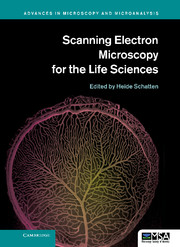45 results
Synaptotagmin 1 regulates cortical granule exocytosis during mouse oocyte activation
-
- Article
-
- You have access
- Open access
- HTML
- Export citation
Low Voltage SEM and Correlative Microscopy to Analyze Delicate Biological Material
-
- Journal:
- Microscopy and Microanalysis / Volume 21 / Issue S3 / August 2015
- Published online by Cambridge University Press:
- 23 September 2015, pp. 507-508
- Print publication:
- August 2015
-
- Article
-
- You have access
- Export citation
12 - Chromosome behavior and spindle formation in mammalian oocytes
- from Section 3 - Developmental biology
-
-
- Book:
- Biology and Pathology of the Oocyte
- Published online:
- 05 October 2013
- Print publication:
- 24 October 2013, pp 142-153
-
- Chapter
- Export citation
Clathrin Heavy Chain 1 is Required for Spindle Assembly and Chromosome Congression in Mouse Oocytes
-
- Journal:
- Microscopy and Microanalysis / Volume 19 / Issue 5 / October 2013
- Published online by Cambridge University Press:
- 02 July 2013, pp. 1364-1373
- Print publication:
- October 2013
-
- Article
- Export citation
Contributors
-
-
- Book:
- Paternal Influences on Human Reproductive Success
- Published online:
- 05 April 2013
- Print publication:
- 11 April 2013, pp ix-x
-
- Chapter
- Export citation
Chapter 6 - The role of the sperm centrosome in reproductive fitness
-
-
- Book:
- Paternal Influences on Human Reproductive Success
- Published online:
- 05 April 2013
- Print publication:
- 11 April 2013, pp 50-60
-
- Chapter
- Export citation
Contents
-
- Book:
- Scanning Electron Microscopy for the Life Sciences
- Published online:
- 05 January 2013
- Print publication:
- 06 December 2012, pp v-vi
-
- Chapter
- Export citation
Scanning Electron Microscopy for the Life Sciences - Half title page
-
- Book:
- Scanning Electron Microscopy for the Life Sciences
- Published online:
- 05 January 2013
- Print publication:
- 06 December 2012, pp i-i
-
- Chapter
- Export citation
1 - The role of scanning electron microscopy in cell and molecular biology:
-
-
- Book:
- Scanning Electron Microscopy for the Life Sciences
- Published online:
- 05 January 2013
- Print publication:
- 06 December 2012, pp 1-15
-
- Chapter
- Export citation
Endorsements
-
- Book:
- Scanning Electron Microscopy for the Life Sciences
- Published online:
- 05 January 2013
- Print publication:
- 06 December 2012, pp vii-viii
-
- Chapter
- Export citation
Scanning Electron Microscopy for the Life Sciences - Title page
-
-
- Book:
- Scanning Electron Microscopy for the Life Sciences
- Published online:
- 05 January 2013
- Print publication:
- 06 December 2012, pp iii-iii
-
- Chapter
- Export citation
Contributors
-
-
- Book:
- Scanning Electron Microscopy for the Life Sciences
- Published online:
- 05 January 2013
- Print publication:
- 06 December 2012, pp ix-xii
-
- Chapter
- Export citation
Plates - PDF Only
-
- Book:
- Scanning Electron Microscopy for the Life Sciences
- Published online:
- 05 January 2013
- Print publication:
- 06 December 2012, pp -
-
- Chapter
- Export citation
Series page
-
- Book:
- Scanning Electron Microscopy for the Life Sciences
- Published online:
- 05 January 2013
- Print publication:
- 06 December 2012, pp ii-ii
-
- Chapter
- Export citation

Scanning Electron Microscopy for the Life Sciences
-
- Published online:
- 05 January 2013
- Print publication:
- 06 December 2012
Index
-
- Book:
- Scanning Electron Microscopy for the Life Sciences
- Published online:
- 05 January 2013
- Print publication:
- 06 December 2012, pp 257-261
-
- Chapter
- Export citation
Copyright page
-
- Book:
- Scanning Electron Microscopy for the Life Sciences
- Published online:
- 05 January 2013
- Print publication:
- 06 December 2012, pp iv-iv
-
- Chapter
- Export citation
Introduction to Stem Cell Special Section
-
- Journal:
- Microscopy and Microanalysis / Volume 17 / Issue 4 / August 2011
- Published online by Cambridge University Press:
- 11 July 2011, p. 473
- Print publication:
- August 2011
-
- Article
-
- You have access
- HTML
- Export citation
The Significant Role of Centrosomes in Stem Cell Division and Differentiation
-
- Journal:
- Microscopy and Microanalysis / Volume 17 / Issue 4 / August 2011
- Published online by Cambridge University Press:
- 11 July 2011, pp. 506-512
- Print publication:
- August 2011
-
- Article
- Export citation
Preface: Multiphoton Microscopy
-
- Journal:
- Microscopy and Microanalysis / Volume 14 / Issue 6 / December 2008
- Published online by Cambridge University Press:
- 06 November 2008, p. 481
- Print publication:
- December 2008
-
- Article
-
- You have access
- HTML
- Export citation

